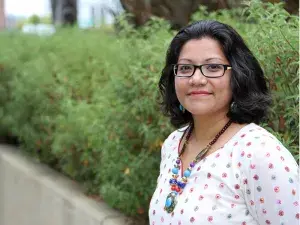
Preeti Nair
Associate Professor PhD, PTPrograms and Courses Taught
Doctor of Physical Therapy
PT724- Functional Anatomy Biomechanics and Kinesiology 1
PT726- Functional Anatomy Biomechanics and Kinesiology 2
PT755- Evidence Based Practice 1
PT702- Capstone 2- Exploration and planning
PT703- Capstone 3- Implementation
PT704- Capstone 4- Completion
About Me
As a faculty member in the Department of Physical Therapy and being a clinician, an educator, and a researcher, my goal in the DPT program is to prepare students to be active critical thinkers and change agents in the community. A part of my teaching philosophy is to motivate students to always challenge the norm set in clinical practice so they can raise the bar higher with their critical thinking and creativity.
Education
I earned my Bachelor of Physiotherapy at Pune University in India. I then earned a PhD in Rehabilitation Sciences at the University of Florida, with a research focus on Biomechanics and Neurophysiology of walking in individuals with neurological impairment. I was able to enhance and apply my research and learn newer cutting edge ways to access the potential of the nervous system by completing a post doctoral fellowship at the Sensory Motor Performance Program at the Shirley Ryan Ability Lab (formerly known as the Rehabilitation Institute of Chicago).
Teaching Interests
Through teaching, one has the opportunity to motivate, empower and emancipate a person. Students are like clay and to shape and channelize their potential into something meaningful takes a lot of thought and structuring on the part of the teacher. One of the main goals of this process is to encourage critical thinking and analytical reasoning among students and to enhance their problem solving skills. I have had several opportunities to teach thus far, and I have realized from my earlier role models and my own teaching experience what a great gift it is to share the subject matter you love with others. For me teaching therefore transcends from being a mere job responsibility to becoming a passion to share, learn and make better.
Scholarly Interests
My research over the past several years has spanned across two domains:
a) Developing a broader repertoire of understanding the individual and collective components/ systems of normal walking and their respective contributions to walking impairment. Specifically, the goal is to study the contributions of the central nervous system and the musculoskeletal system in sculpting normal and impaired walking behavior.
b) Developing a therapist- friendly algorithm utilizing this knowledge for effective treatment planning and clinical decision- making. Specifically, the goal is to evaluate what we know and do in practice and support or dispute its relevance by utilizing a scientific approach.
Publications
- Peacock M, Douglas S, Nair P. Neural Mobilization in Radicular Low Back Pain: A Systematic Review. J Man Manip Ther. 2022; May 18;1-9.
- Lew J, Kim J, Nair P. Comparison of dry needling and trigger point manual therapy in patients with neck and upper back myofascial pain syndrome: A systematic review and meta-analysis. J Man Manip Ther. 2021; Jun;29(3):136-146 Nair PM, Phadke CP, Behrman AL. Phase dependent modulation of soleus H-reflex in healthy, non-injured individuals while walking with and without an ankle foot orthosis. Gait Posture. 2014; Apr;39(4):1086-91.
- Nair PM, Hornby TG, Behrman AL. Minimal detectable change for spatial and temporal measurements of gait after incomplete spinal cord injury. Top Spinal Cord Inj Rehabil. 2012; 18(3):273–281.
- Phadke CP, Thompson FJ, Kukulka CG, Nair PM, Bowden MG, Madhavan S, Trimble MH, Behrman AL. Soleus H-reflex modulation after motor incomplete spinal cord injury: Effect of body position and walking speed. J Spinal Cord Med. 2010; 33(4):371-8.
- Nair PM, Behrman AL. Spinal cord injury: Role of ankle foot orthoses. Low Extrem Rev. 2010; 2(8): 47:52.
- Nair PM, Rooney KL, Kautz SA, Behrman AL. Stepping with an ankle foot orthosis re- examined: a mechanical perspective for clinical decision making. Clin Biomech. 2010 Jul;25(6):618-22.
- Fox E, Tester N, Phadke C, Nair P, Senesac C, Howland D, Behrman A. Ongoing walking recovery 2 years after locomotor training in a child with severe incomplete spinal cord injury. Phys Ther. 2010 May;90(5):793-802.
- Bowden M, Hannold L, Nair P, Fuller L, Behrman A. Beyond gait speed: A case report of a multidimensional approach to locomotor rehabilitation outcomes in incomplete spinal cord injury. J Neurol Phys Ther. 2008 Sep; 32(3):129-138.
- Behrman A, Nair P, Bowden M, Dauser, R, Herget B, Martin J, Phadke C, Reier P, Senesac C, Thompson F, Howland D. Locomotor training restores walking in a non- ambulatory child with severe, chronic, cervical incomplete spinal cord injury. Phys Ther. 2008 May; 88(5):580-90.
- Behrman AL, Bowden MG, Nair PM. Neuroplasticity after spinal cord injury and training: an emerging paradigm shift in rehabilitation and walking recovery. Phys Ther. 2006 Oct; 86(10):1406-25.
- Behrman AL, Lawless-Dixon AR, Davis SB, Bowden MG, Nair P, Phadke C, Hannold EM, Plummer P, Harkema SJ. Locomotor training progression and outcomes after incomplete spinal cord injury. Phys Ther. 2005 Dec; 85(12):1356-71.
Honors & Awards
- SMU Faculty Scholarship Grant Program ($35,000) Participation: Principal Investigator. Investigating self-reported fatigue and motor fatigue in persons with Multiple Sclerosis
Goal: The study examines the degradation of muscle activation and gait over the 12 Minute Walk Test in persons with Multiple Sclerosis and examines the correlation between subjective fatiguability and rate of perceived exertion